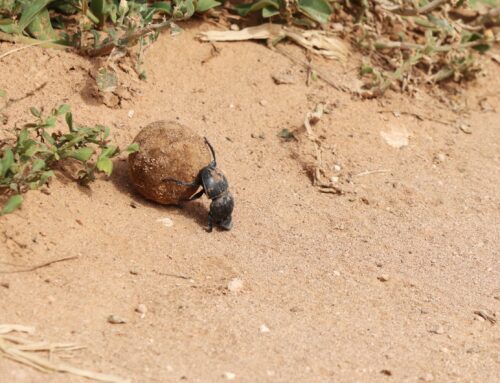Earth´s atmosphere consists of 78% nitrogen, 21% oxygen and 1% of other gases, such as carbon-dioxide. Except the oxygen that we breathe, all other building elements of life (C, N, H, P, S and others) we must take by eating or by drinking. Fishes can take oxygen directly from water, while photosynthetic organisms, such as plants, can bind atmospheric carbon-dioxide. However, only living creatures on our planet able to use nitrogen gas (N2) directly from the atmosphere, are microorganisms called Nitrogen-Fixers or Diazotrophs. In the ocean, they are Cyanobacteria, while in the soil, they are several species of bacteria and others, so-called Archea. Some of them are living free in the soil, while others can bind nitrogen only through a special symbiotic relationship with plant roots. Without the N-Fixers in the ocean and soil, plants would not be able to get nitrogen and our whole food chain would collapse. This is one reason why microbiome research in these areas is of tremendous importance.
Anyway, I won´t bother you with the details about Nitrogen Cycle – these you can find in any bigger biology book or on the internet. Today, we need to address several urgent questions regarding the roles of microbiomes in our food production:
How soil and plant microbiome can help our plants to use better soil nutrients, grow better and have better yields?
How plant and soil microbiome can help us to grow plants which are more resilient to the pests and the other effects of global climate changes such as land degradation, deforestation, desertification, etc.?
How microbiomes can help us mitigate the damages we have already done to the environment?
Finally, I would also like to provide a brief overview of the current microbiome-based products and solutions in this area -some of them already on the market and others in the development.
“You never know what the future holds in the shallow soil of Monsanto, Monsanto
The moon is full and the seeds are sown while the farmer toils for Monsanto, Monsanto
When these seeds rise they’re ready for the pesticide
And Roundup comes and brings the poison tide of Monsanto, Monsanto”
“Monsanto Years” (Neil Young, 2015)
Hazards of synthetic Nitrogen Fertilizers
More than 100 years ago, chemists discovered how to synthesize ammonia from nitrogen gas. It was a crucial step for chemical synthesis of inorganic nitrogen fertilizers. During last fifty years, global production of inorganic N-based fertilizers increased seven-fold and it is estimated that around half or the global crop production is enhanced by them1. However, problem is that most plant species can use only between 30%-50% of nitrogen added by fertilizers, while the rest of it is used by microorganisms in the soil, washed away into the water streams or evaporated. Consequences are multiple and detrimental: 1) soil structure changes and it becomes difficult to supply plants with nutrients; 2) soil microbiomes change, become less diverse and create further long-term negative effects; 3) groundwaters become contaminated, leading to the increased concentrations of nitrates in rivers and coastal areas, causing algal bloom and creation of so-called “dead coastal zones”; 4) nitrates consumed by humans and animals (e.g. by contaminated water, vegetables or seeds) become converted by microbes in the body to toxic or carcinogenic compounds (nitrites, nitrosamines etc.); 5) nitrous oxide (N2O) is a greenhouse gas more than 250 times potent than CO2; 6) ammonia gas (NH3) and other nitrogen oxides (NOx) in the air are causing various respiratory disorders in humans (asthma, bronchitis etc.), as well as various negative effects on other terrestrial plants and animals 1, 2, 3.
“Hey farmer, farmer put away that DDT now
Give me spots on my apples, but leave me the birds and the bees”
“Big Yellow Taxi” (Joni Mitchell, 1973)
Pesticides
Pesticides are chemical compounds, inorganic or organic, natural or synthetized, deliberately released into environment to kill an organism. Depending on the target organisms they are classified as insecticides (insects), fungicides (fungi), herbicides (weed plants) and others. One of the first massively applied pesticides was DDT. It took several decades until people realized its toxicity and environmental pollution. Since 1950s use of DDT has been gradually limited and the next generations of pesticides were designed to avoid similar harmful effects. Unfortunately, many current pesticides are still not easily degradable in the environment and can accumulate in soil and fresh waters in thousand-fold higher concentrations than intended, directly negatively affecting soil microorganisms and the availability of the soil nutrients for plants. Besides microorganism, pesticides negatively affect many insect species which are either beneficial or competitors for the pest-species. Decline in populations of the pollinator insects, such as honey bees, is a huge global problem. In some parts of the world, bee colonies are lost at the rate of more than 40% annualy.6, 12 Reported effects of human exposure to pesticides are diverse: from respiratory conditions, asthma, cancer, diabetes, Parkinson´s disease, cognitive disorders, leukemia and others 4, 5, 6.
Possible solutions
There are basically two “frontlines” along which our battle for the global plant-based food is being fought:
1) how to improve plant yields?
2) how to create plants more resilient to pests and abiotic factors (heat, frost, drought, salinity etc.)?
One possibility is selection of plants with desired traits. Many researchers and companies around the world are trying to use latest technological developments (such as Next Generation Sequencing) to improve plant breeding by genotyping and phenotyping. This topic is very interesting but unfortunately too large for this blog. Other attempts to improve plant yields are focused on creation of new generation of more “environmentally-friendly” fertilizers, so called Efficiency Enhanced Fertilizers (EEF). Generally, nitrogen from fertilizers is better utilized by plants if it is released slowly. A good example is traditional fertilization of fields by manure. Newer EEFs are using, for example, urea-based compounds with special coatings, as well as micronutrients, nanotechnology and other methods 7.
Next interesting option to increase nutrient uptake and / or to increase plant resistance to abiotic stress is by so-called Biostimulants. They can be non-microbial (e.g. organic or inorganic extracts) or microbial. A microorganism promoting natural plant nutrient uptake is called “Plant Growth Promoting Microorganism“, or shortly PGPM. PGMPs can be bacteria, fungi, Protozoa and nematodes.
Regarding plant resilience to pests, Biopesticides are an alternative to the conventional pesticides. They are defined as “a form of pesticide based on micro-organisms or natural products” 9. Natural products used as biopesticides are typically plant extracts or pheromones. Microorganisms, such as fungi, bacteria and others with plant-protecting properties are classified as “Microbial Biological Control Agents” or shortly MBCA 10, 11. Global market for microbe-based biofertilizer and biopesticides is currently booming and it is projected to reach multi-billion-dollar value in the next couple of years12.
Current trends of microbiome-based agricultural products
Nitrogen-fixing bacteria were the first microorganisms used as biofertilizers, as early as 189612. Until today, single bacterial or fungal species are used as PGMPs or MBCAs in the form of sprays, liquids or seed coatings. Examples include companies like Alltech, Vallagro, AgBiome, Marrone Bioinnovations, Plantresponse, NewLeaf Symbiotics, Agroliquid and others. Few companies in this area, such as Agradis or AgraQuest have become recent multi-million acquisitions by Bayer, emphasizing the trends on the market.
Precisely defined microbial mixtures, or so-called “Artificial Microbial Consortia” (AMC) represent the second generation of microbiome-based agricultural solutions. Examples include companies such as Indigo, Concentric or Growcentia. Another recent approach is engineering of microbes for better nutrient uptake by plants. Examples are Pivot Bio or JOYN. With new technologies such as NGS, a quick assessment of the soil microbiome-quality and needs becomes possible, a good example of which is company Biome Makers. Future trends will probably include integration of more “omics” approaches, data science, machine learning and automation, a recent example of which is Zymergen.
Future of microbiome-based agricultural management and market entry considerations
Complex interactions and communication between plant hosts and their associated microbes and insects are an emerging area of research. Plant traits supporting beneficial microbial communities, stability of single microbial species and microbial communities under the field conditions, their interactions with other microbes and beneficial insects as well as long-term effects of these approaches are only some of the questions to be answered. Differences between plants and growing conditions (outdoor, indoor, aquaponics, urban etc.) need to be considered and more individual approaches developed. Close collaboration between industry, researchers and growers is essential to achieve these goals12.
On the regulatory side, some plant-growth-promoting microbial products can simultaneously provide plant protection. Other way round, there are plant protections products (PPPs), such as MBCAs, having a plant growth-promoting property. In European Union, for example, registration of Plant Protection Products (PPPs) is a complicated process and companies often try to register their products as PGMPs or Fertilizers. In general, biostimulants have not been tightly regulated in EU, UK and USA. However, newer US and EU regulations from 2018 and 2019 indicate changes in this field and other markets (e.g. South-East Asia) are following these trends 10, 11.
If you are interested to learn more about any of the topics mentioned above, please do not hesitate to contact us at: www.microbiomepower.com.
References:
1. Moddassir Ahmed, Muhammad Rauf, Zahid Mukhtar, Nasir Ahmad Saeed. 2017. Environ Sci Pollut Res. Excessive use of nitrogenous fertilizers: an unawareness causing serious threats to environment and human health
2. Moddassir Ahmed, Muhammad Rauf, Muhammad Akhtar, Zahid Mukhtar and Nasir Ahmad Saeed. 2020. Environmental Science and Pollution Research. Hazards of nitrogen fertilizers and ways to reduce nitrate accumulation in crop plants.
3. Jan Willem Erisman,James N Galloway, Sybil Seitzinger, Albert Bleeker,Nancy B Dise, A M Roxana Petrescu, Allison M Leach, Wim de Vries. 2013. Philos Trans R Soc Lond B Biol Sci. Consequences of human modification of the global nitrogen cycle.
4. B S Choudri,Yassine Charabi, Noura Al-Nasiri, Talal Al-Awadhi. 2020. Pesticides and herbicides. Water Environ Res. 92(10):1425-1432
5. Ki-Hyun Kim, Ehsanul Kabir, Shamin Ara Jahan. 2017. Exposure to pesticides and the associated human health effects. Sci Total Environ. 1; 575:525-535.
6. Scott T O’Neal, Troy D Anderson, Judy Y Wu-Smart. Interactions between pesticides and pathogen susceptibility in honey bees. 2018, Curr Opin Insect Sci; 26:57-62.
7. Christian O. Dimkpa, Job Fugice, Upendra Singh, Timothy D. Lewis. Development of fertilizers for enhanced nitrogen use efficiency – Trends and perspectives. Science of the Total Environment 2020., 731, 139113
8. Nicholas Ozede Igiehon ID and Olubukola Oluranti Babalola. Rhizosphere Microbiome Modulators: Contributions of Nitrogen Fixing Bacteria towards Sustainable Agriculture. Int. J. Environ. Res. Public Health 2018, 15, 574
9. “Encouraging innovation in biopesticide development”. European Commission DG ENV. https://ec.europa.eu/environment/integration/research/newsalert/pdf/134na5_en.pdf
10. KTN Report on Biostimulants and their potential role in sustainable agricultiurural production systems (KTN, UK, March 2021) https://ktn-uk.org/news/plant-biostimulants-and-their-potential-role-in-sustainable-agricultural-production-systems/
11. Sheridan L. Woo and Olimpia Pepe. Microbial Consortia: Promising Probiotics as Plant Biostimulants for Sustainable Agriculture. Frontiers in Pant Science. 2018, Volume 9, Article 1801
12. French, E., Kaplan, I., Iyer-Pascuzzi, A.et al.Emerging strategies for precision microbiome management in diverse agroecosystems. 2021, Nat. Plants.7, 256–267





